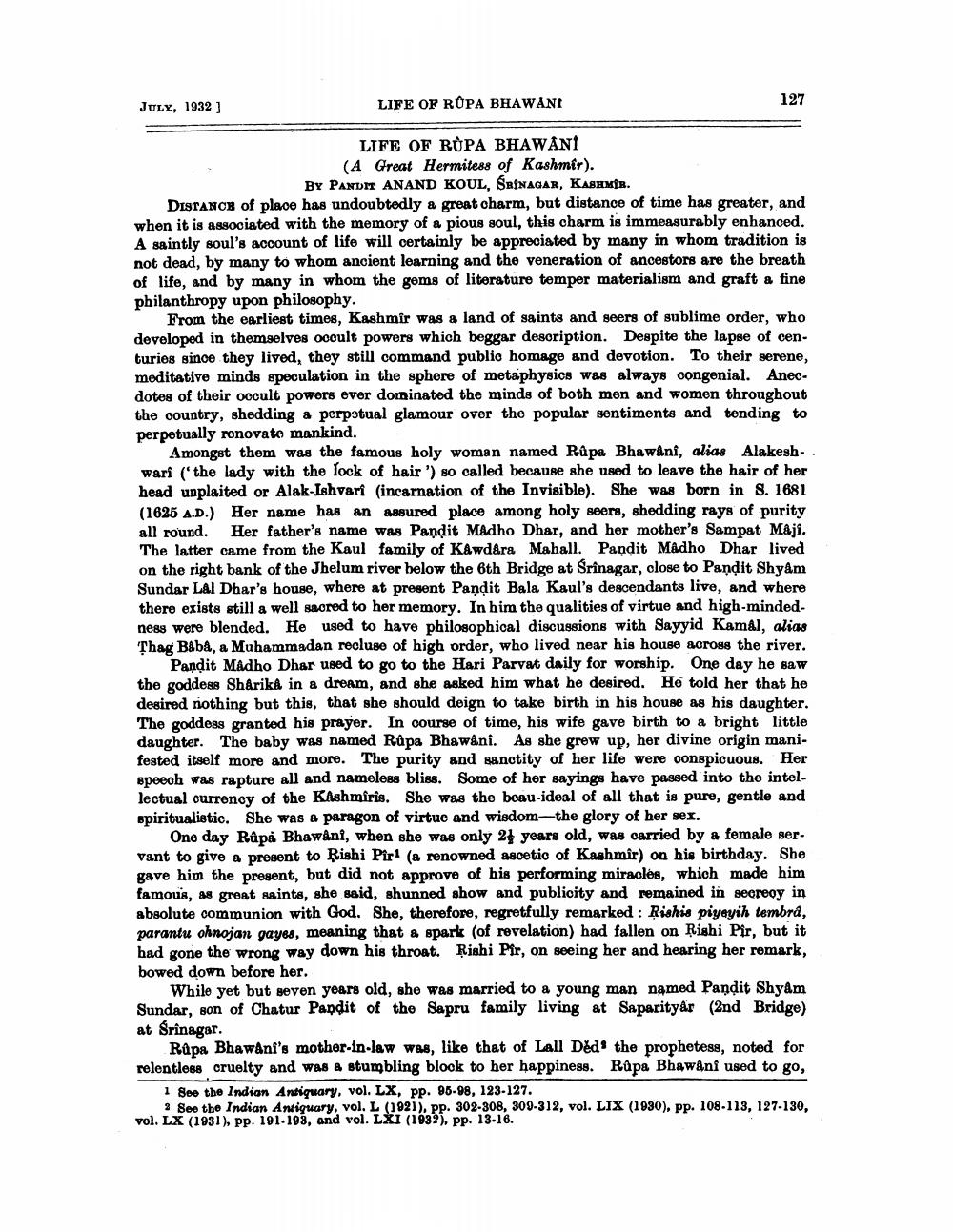________________
LIFE OF ROPA BHAWANI
JULY, 1932 ]
127
LIFE OF RÛPA BHAWANI
(A Great Hermitess of Kashmir).
BY PANDIT ANAND KOUL, SRINAGAR, KASTMİR. DISTANCE of place has undoubtedly a great charm, but distanoe of time has greater, and when it is associated with the memory of a pious soul, this charm is immeasurably enhanced. A saintly soul's account of life will certainly be appreciated by many in whom tradition is not dead, by many to whom ancient learning and the veneration of ancestors are the breath of life, and by many in whom the gems of literature temper materialism and graft a fine philanthropy upon philosophy.
From the earliest times, Kashmir was a land of saints and geers of sublime order, who developed in themselves oocult powers which beggar description. Despite the lapse of centuries since they lived, they still command public homage and devotion. To their serene, meditative minds speculation in the sphere of metaphysics was always oongenial. Anecdotes of their oocult powers ever dorinated the minds of both men and women throughout the country, shedding & perpetual glamour over the popular sentiments and tending to perpetually renovate mankind.
Amongst them was the famous holy woman named Rûpa Bhawani, alias Alakesh wari ("the lady with the lock of hair ') so called because she used to leave the hair of her head unplaited or Alak-Ishvari (incarnation of the Invisible). She was born in S. 1681 (1625 A.D.) Her name has an assured place among holy seers, shedding rays of purity all round. Her father's name was Pandit Madho Dhar, and her mother's Sampat Maji. The latter came from the Kaul family of Kawdåra Mahall. Pandit Madho Dhar lived on the right bank of the Jhelum river below the 6th Bridge at Srinagar, close to Pandit Shyam Sundar Lal Dhar's house, where at present Pandit Bala Kaul's descendants live, and where there exists still a well sacred to her memory. In him the qualities of virtue and high-mindedness were blended. He used to have philosophical discussions with Sayyid Kamal, alias Thag Baba, a Muhammadan recluse of high order, who lived near his house across the river.
Pandit Madho Dhar used to go to the Hari Parvat daily for worship. One day he saw the goddess Sharike in a dream, and she asked him what he desired. He told her that he desired nothing but this, that she should deign to take birth in his house as his daughter. The goddess granted his prayer. In course of time, his wife gave birth to a bright little daughter. The baby was named Rûpa Bhawani. As she grew up, her divine origin manifested itself more and more. The purity and sanctity of her life were conspicuous. Her speech was rapture all and nameless bliss. Some of her sayings have passed into the intellectual currency of the Kashmiris. She was the beau-ideal of all that is pure, gentle and spiritualistic. She was a paragon of virtue and wisdom--the glory of her sex.
One day Râpå Bhawani, when she was only 21 years old, was carried by a female ser. vant to give a present to Rishi Pirl (a renowned asvetio of Kashmir) on his birthday. She gave him the present, but did not approve of his performing miracles, which made him famous, as great saints, she said, shunned show and publicity and remained in secreoy in absolute communion with God. She, therefore, regretfully remarked : Rishis piyayih tembra, parantu ohnojan gayes, meaning that a spark (of revelation) had fallen on Rishi Pir, but it had gone the wrong way down his throat. Rishi Pir, on seeing her and hearing her remark, bowed down before her.
While yet but seven years old, she was married to a young man named Pandit Shyam Sundar, son of Chatur Pandit of the Sapru family living at Saparityår (2nd Bridge) at Srinagar.
Rupa Bhawani's mother-inlaw was, like that of Lall Ded! the prophetess, noted for relentless cruelty and was a stumbling block to her happiness. Rūpa Bhawani used to go,
1 8ve the Indian Antiquary, vol. LX, pp. 96-98, 123-127.
3 See the Indian Antiquary, vol. L (1921), pp. 302-308, 309-312, vol. LIX (1930), pp. 108-113, 127-130, vol. LX (1931), pp. 191.193, and vol. LXI (1932), pp. 13-16.




